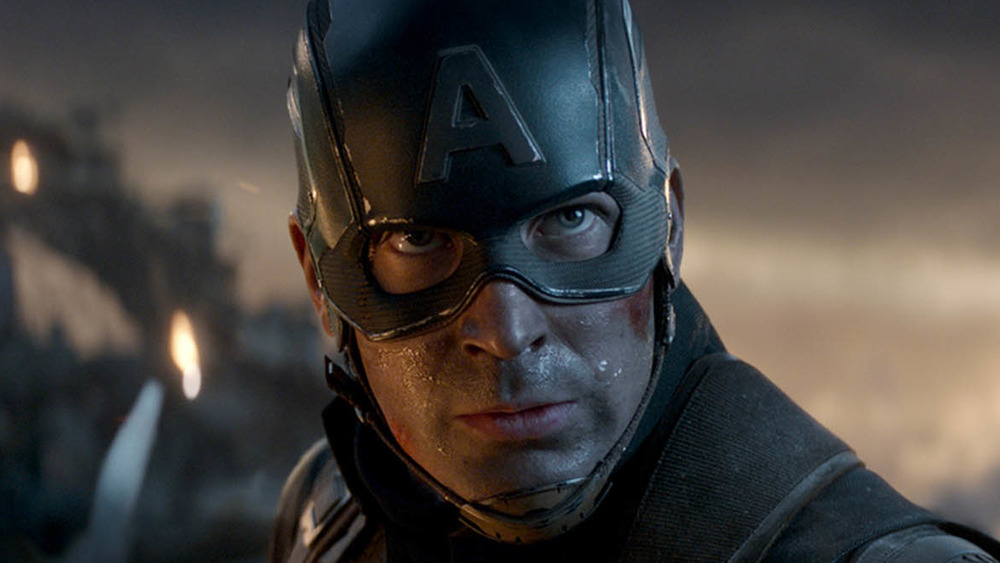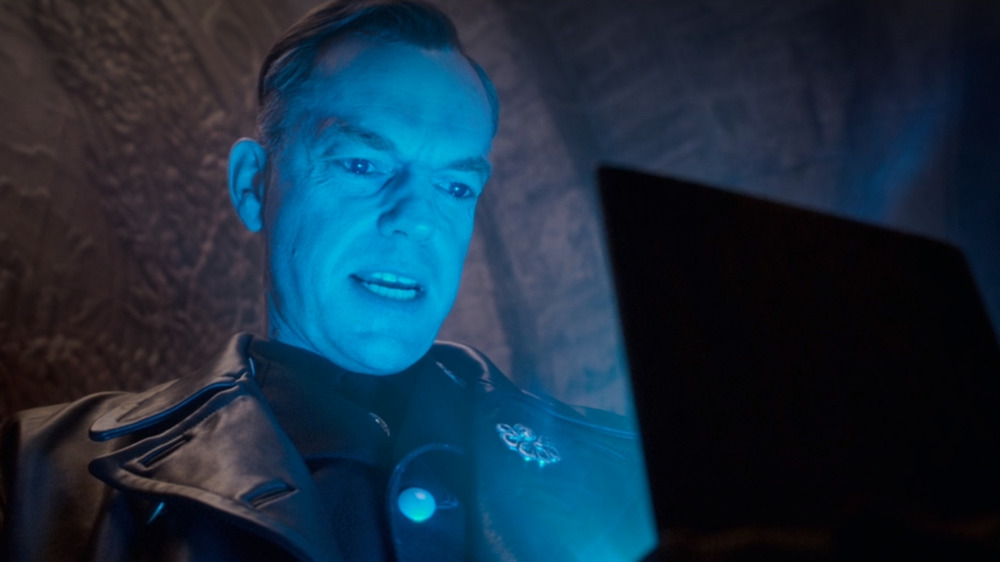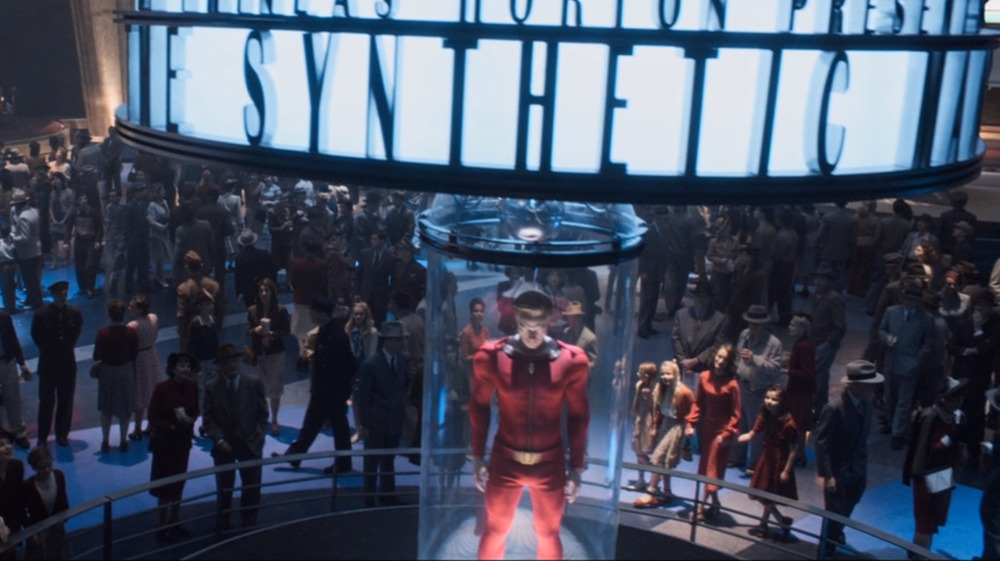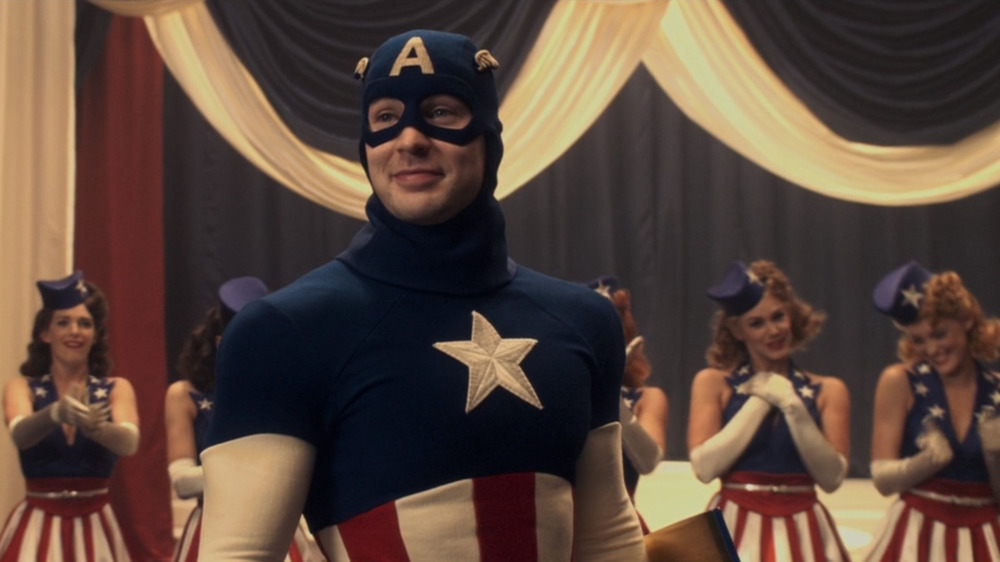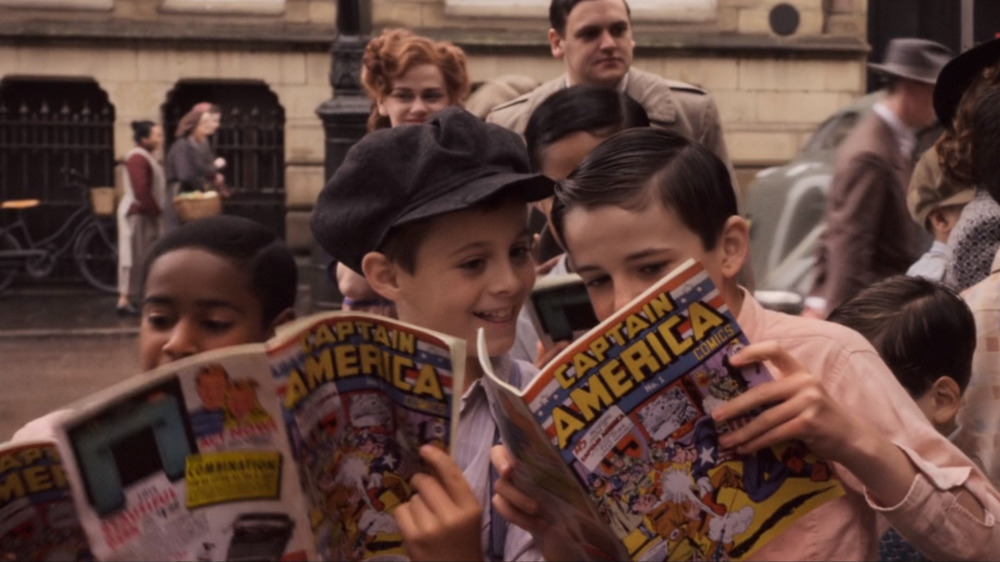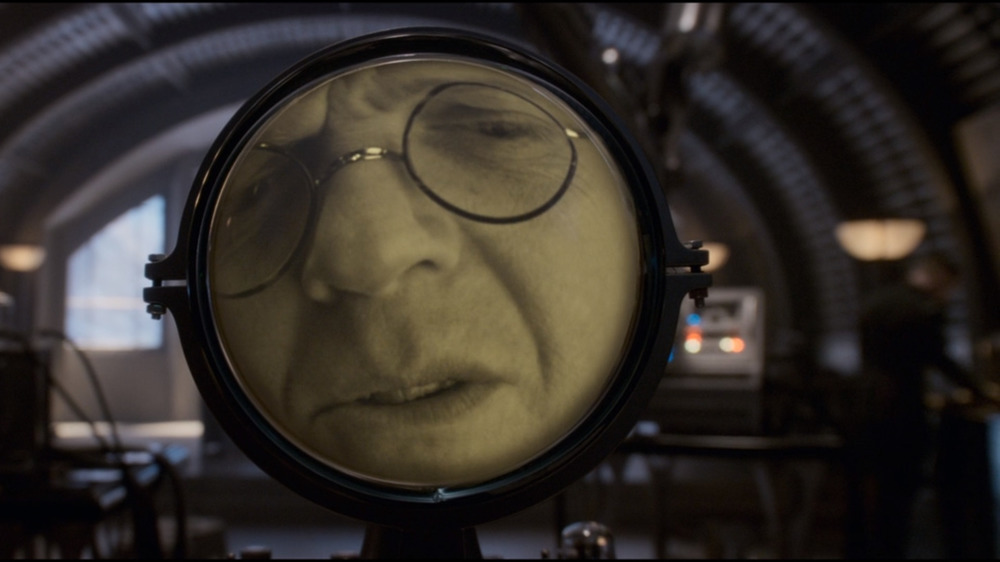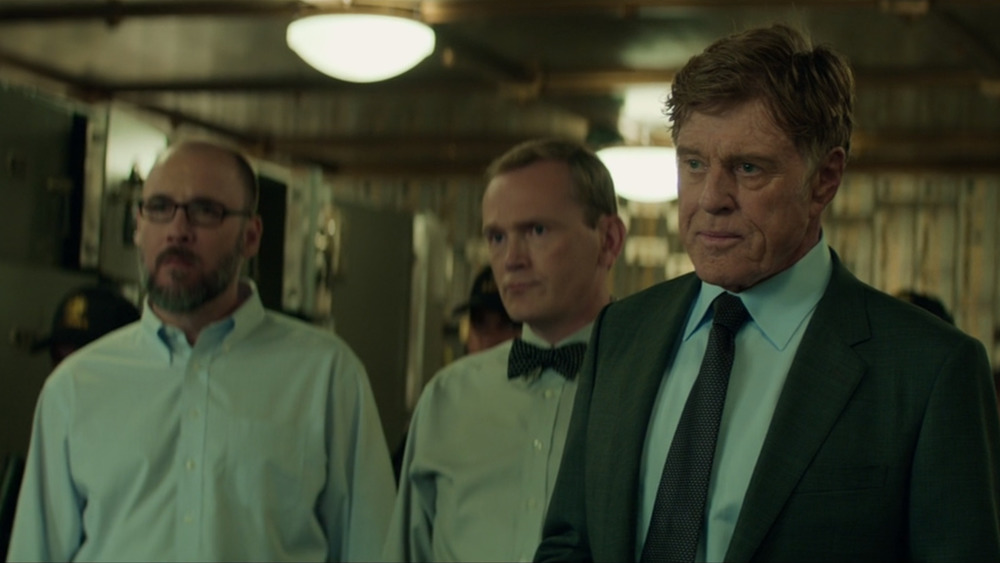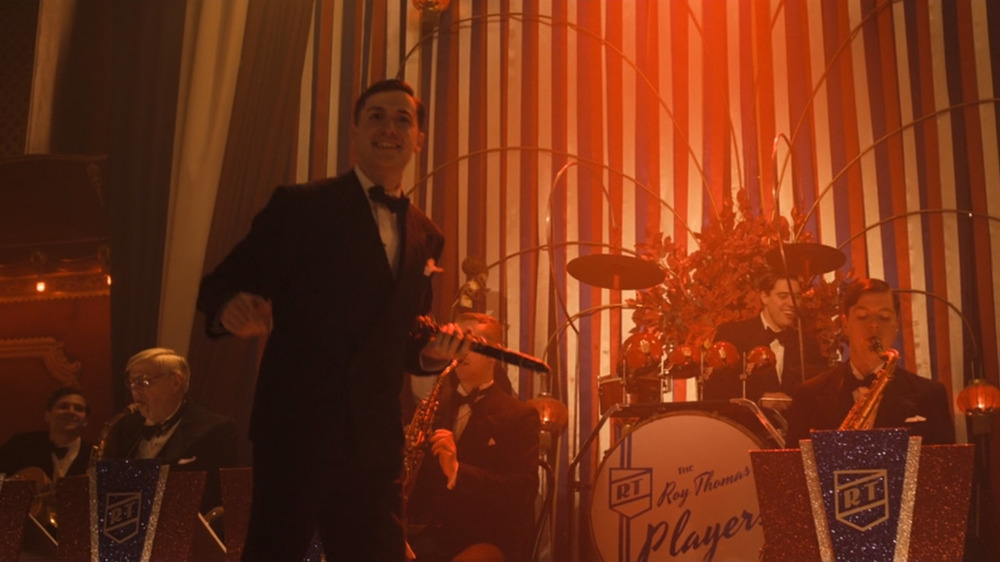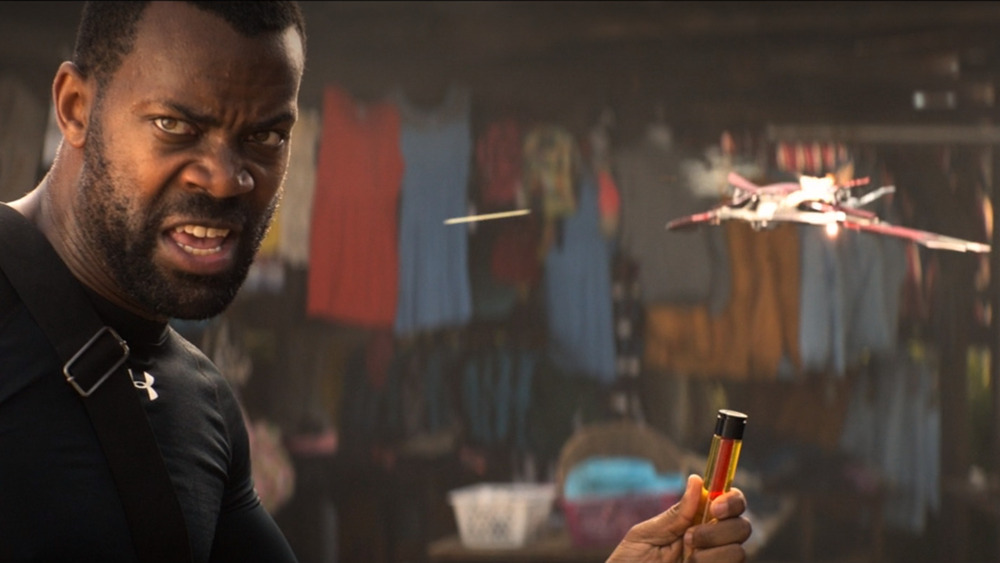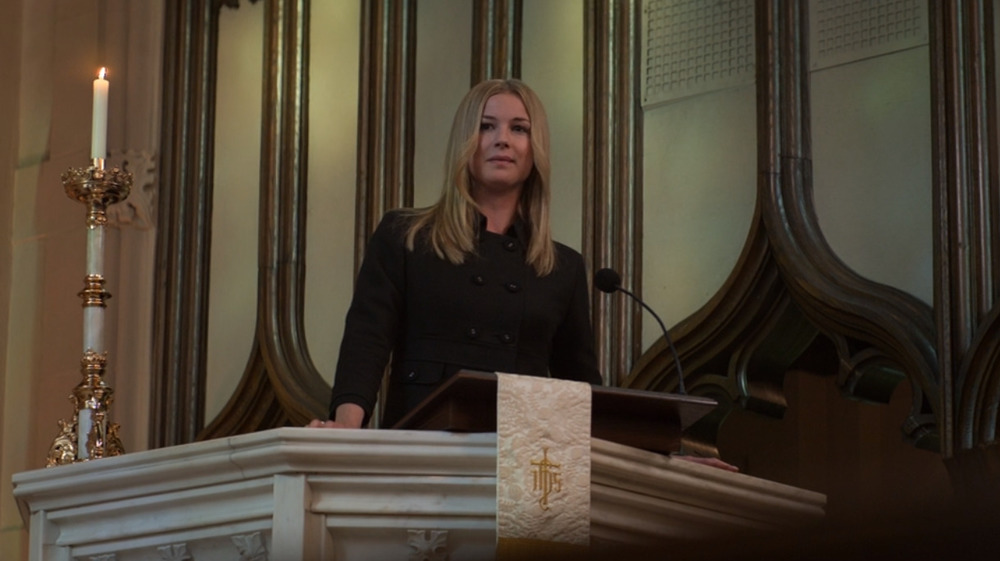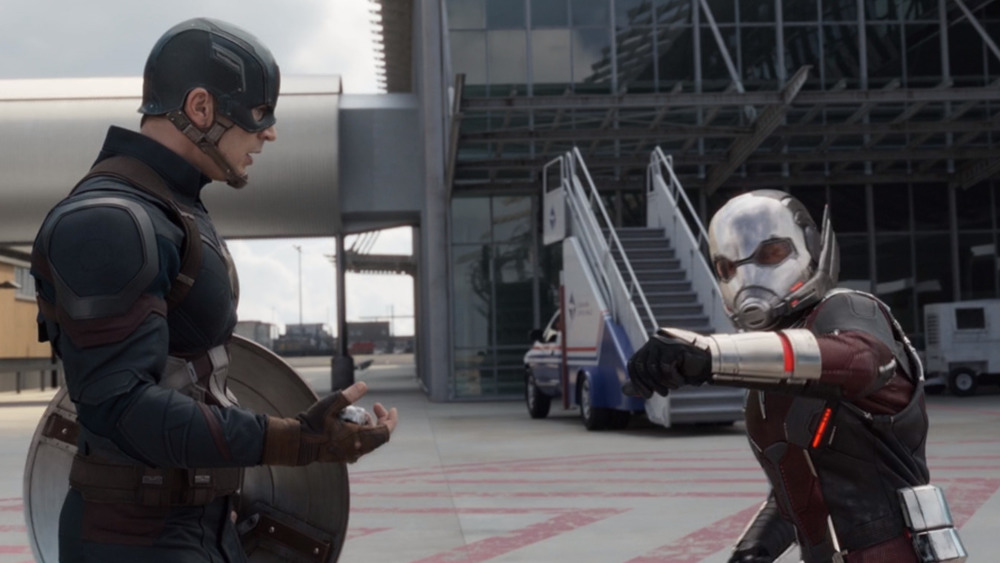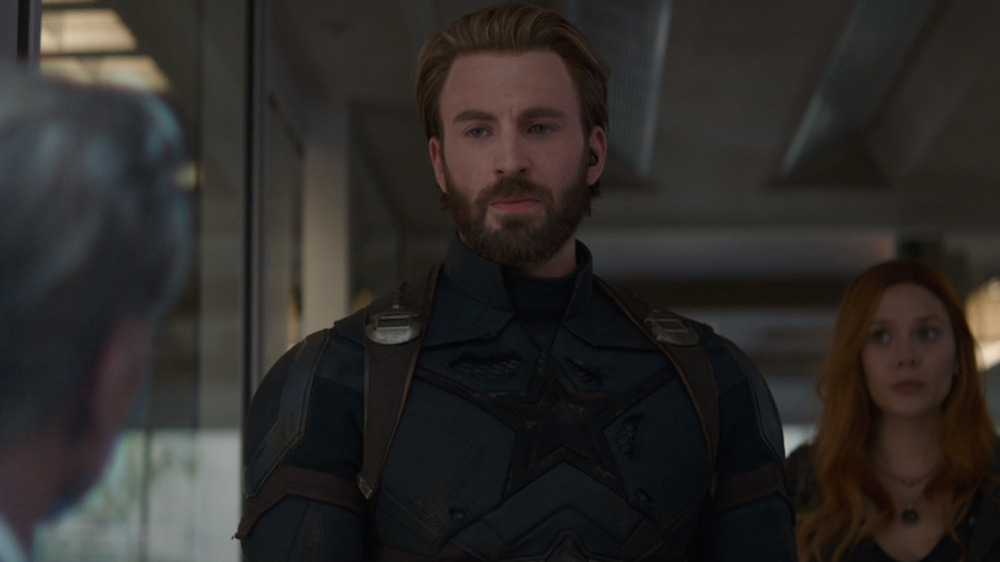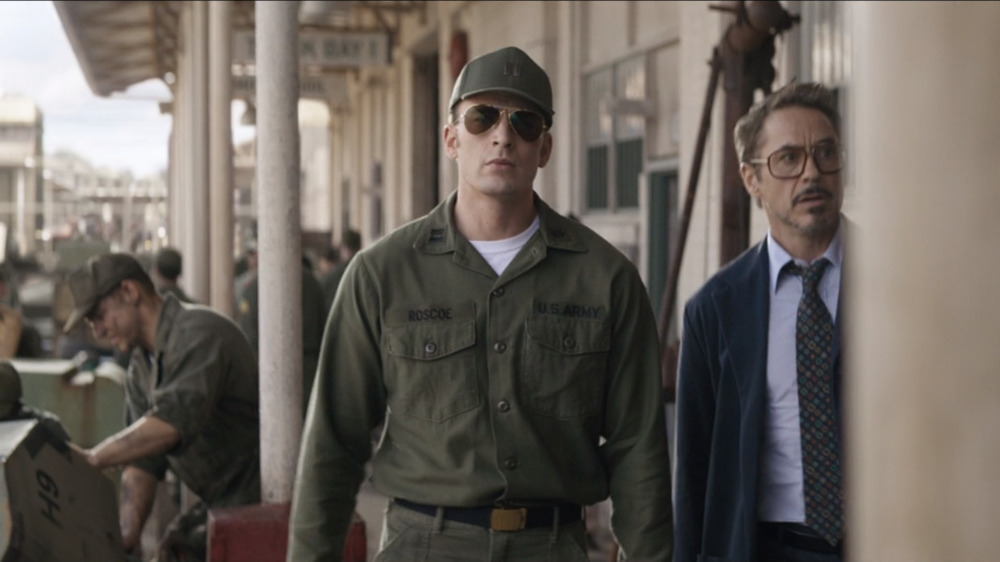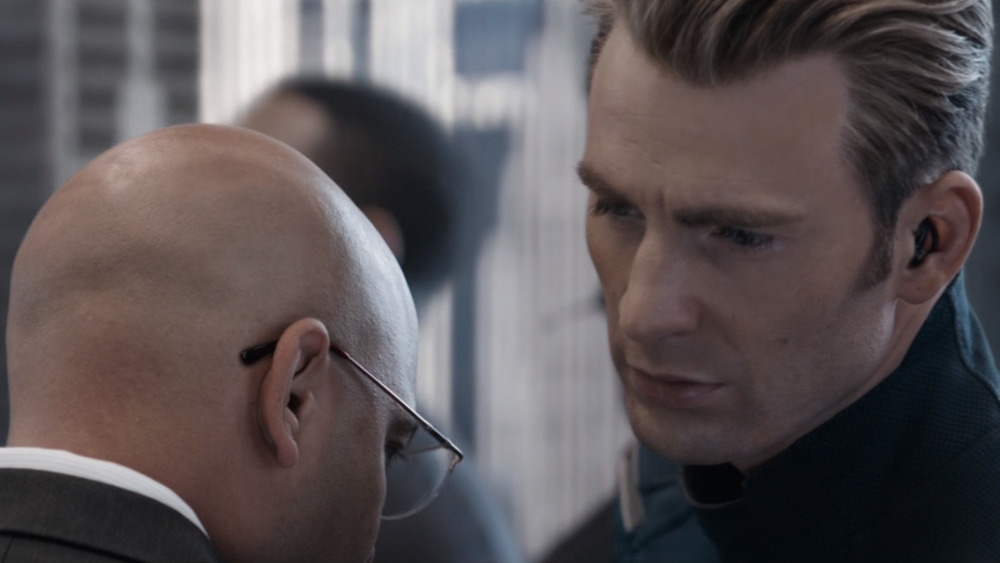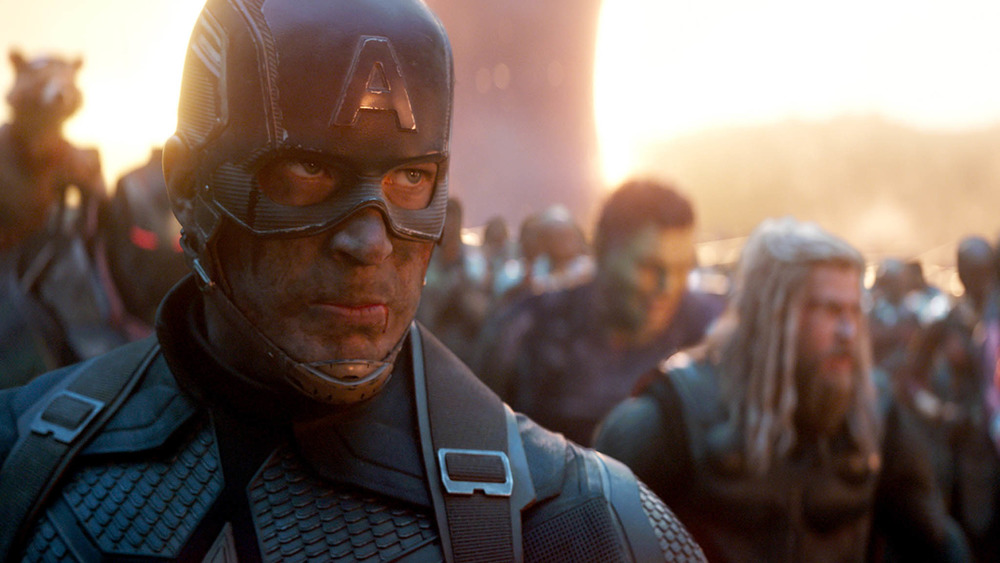The Best Captain America Easter Eggs In The MCU
The Marvel Cinematic Universe is driven by two primary engines. The first is the fact that, while it's possible to have a good time watching any individual MCU film, viewers who have consumed the franchise's entire oeuvre can get more out of the shared universe. The second is that the MCU is based on the original shared universe of Marvel Comics, a collection of source material that goes back to 1939. While people who were never comic book fans can now enjoy the comic-reading experience replicated in the movie medium, those who come to the MCU with prior knowledge of Marvel lore can enjoy the inside jokes, character teases, and Easter eggs inserted just for them. And few MCU characters have as many Easter eggs available to them as Captain America (Chris Evans), who has now been a Marvel character for 80 years.
From 2011's Captain America: The First Avenger to 2019's Avengers: Endgame, every Cap appearance in the MCU has been laced with hidden gems for the savvy comic book fan. While most of these are specific to Steve Rogers himself, some Easter eggs reference his supporting cast, other pieces of Marvel history, and the creative output of comic book writers and film directors. Collectively (and in chronological order), these are the MCU's best Captain America Easter eggs.
Raiders of the Lost Tesseract
Some of the MCU's best Easter eggs are the ones that refer to other films. Every movie in Phase 2, for example, features a character losing their arm or hand in tribute to The Empire Strikes Back. One such reference appears at the very beginning of Captain America: The First Avenger, in the scene where Nazi scientist Johann Schmidt, a.k.a. the Red Skull (Hugo Weaving), discovers the Tesseract hidden in Tønsberg, Norway. Upon first laying eyes on the mystical object (which we learn much later is an Infinity Stone), an awe-struck Schmidt mutters, "And the Führer digs for trinkets in the desert," a line that conveys his contempt for Hitler's apparently less fruitful quests for supernatural power.
While it's not explicitly stated, this piece of dialogue immediately calls to mind the 1981 film Raiders of the Lost Ark, in which Hitler does, in fact, dig for the Ark of the Covenant in the deserts of Cairo. Of course, Schmidt ultimately has little grounds for mockery — his attempt to use the Tesseract doesn't go much better than Belloq's attempt to open the Ark, and he's had his own experience with face-melting.
The real first Avenger
Not many MCU characters go back further in Marvel Comics history than Steve Rogers, but one of them shows up early in The First Avenger, and is witnessed by Rogers himself. After Steve is introduced by way of his failed enlistment attempt and his rescue from an inadvisable fight, he and his friend, Bucky Barnes (Sebastian Stan), spend Bucky's last night as a civilian at the 1943 "World Exposition of Tomorrow," a World's Fair-like exhibition in which American scientific luminaries like Howard Stark show off their futuristic technologies. Inside the appropriately-named Modern Marvels pavilion, Steve and Bucky walk past an exhibit called "Dr. Phineas Horton Presents: The Synthetic Man," which appears to feature an android in a red costume.
This is a direct reference to the very first issue of Marvel Comics in 1939, in which a scientist named Phineas Horton unveils a flaming android called the Human Torch. One of Marvel's original superheroes, the Human Torch concept was later refined into the Fantastic Four's non-synthetic but definitely super-powered Johnny Storm — who would later join a branch of the Avengers (and be played in two movies by none other than a pre-Cap Chris Evans).
Cap's wings get clipped
Captain America's comic book costume is iconic, and hasn't changed much over the years despite the plethora of artists who have drawn him. One of its signature elements that still consistently makes it onto the page, even in 2021, is the pair of tiny white wings that stick out from either side of Cap's head. In contrast, the MCU's Captain America costume has gone through numerous changes and alterations — but one thing that's consistently absent are the wings. While several of Cap's film costumes do include wing imagery on his cowl, none of them have an actual, three-dimensional pair of wings stuck to the sides...except one.
In The First Avenger, before Captain America is ever a superhero, he's a promotional tool for the United States military, touring the nation convincing his audiences to buy war bonds. This version of the costume, and only this version, is the quintessential Cap costume from the comics, complete with head wings. The fact that the most faithful version of the costume is treated largely as a sight gag should tell you everything you need to know about the MCU's attitude toward Cap's comic book look.
Captain America vs. Adolf Hitler
Superhero movies are notorious for re-creating famous comic book panels on screen, and the MCU is no exception. The three Captain America films, in particular, tend to do this a lot. The shot of Bucky Barnes, now transformed into the villainous Winter Soldier, punching Cap's shield in Captain America: The Winter Soldier is a direct translation from the comic book story of the same name, while Captain America: Civil War incorporates at least two famous comic book covers: Ant-Man perched atop one of Hawkeye's arrows on the cover of Avengers #223, and Iron Man blasting Cap's shield with repulsor rays on the cover of Civil War #7.
But there's just nothing quite like seeing Captain America punch Adolf Hitler in the face. That's what happens on the cover of 1941's Captain America Comics #1, and we get to see it happen over and over again in the montage of Cap's war bonds tour in The First Avenger. In fact, Captain America Comics #1 actually appears in the film, a symbol of Cap's growing popularity and a loving nod to his publication history as this exact kind of propaganda character.
The Bio-Fanatic
Arnim Zola, a Nazi scientist working for the Red Skull, plays a prominent role in not just the first two Captain America movies, but in the comics as well, becoming a supervillain in his own right and calling himself the Bio-Fanatic. The movies, however, never allow him to realize his modern villainous form — a grotesquely-designed robot body imbued with Zola's consciousness and featuring a giant image of his face housed in its chest. It's one of the many Marvel Comics character designs that have presumably been deemed a bit too silly for the big screen.
But there are definitely several nods to this comic book canon over the course of those first two films. The first time we see Arnim Zola, we don't even see him properly — we see his face distorted and magnified through the lens of one of his machines. Toward the middle of the film, after Schmidt sets the Hydra base to self-destruct, Zola grabs a blueprint on his way out that sure looks like it's for a robot body. And of course, in The Winter Soldier, we learn that Zola's consciousness has indeed survived into the modern world in the form of a secret supercomputer.
Author, author!
The Winter Soldier is adapted from a six-issue story arc of the same name from the Captain America comics that was published from 2005 to 2006. The story, written by Marvel scribe Ed Brubaker, brings back the character of Bucky Barnes as the mysterious antagonist of the title. In penning this narrative, which would ultimately lead to a long MCU career for both Bucky himself and actor Sebastian Stan, it seems fitting that Brubaker would appear in the film whose primary villain he co-created.
About three quarters of the way through The Winter Soldier, S.H.I.E.L.D. official Alexander Pierce (himself a loose carryover from the comics) visits the Winter Soldier following a fight with Captain America. Two scientists are seen whispering together, then standing behind Pierce during his conversation with Bucky, before carrying out Pierce's orders. Brubaker is one of them, credited as "Scientist #2." It's his only acting credit on IMDB.
The Roy Thomas Players
Speaking of comic book writers, Brubaker's cameo isn't the only authorial Easter egg in the Captain America franchise. Everyone knows that legendary Marvel editor Stan Lee had a brief appearance in every MCU film until his death in 2018, but no less important to the history of Marvel Comics is Roy Thomas, who replaced Lee as editor-in-chief in 1972 when Lee stepped away from writing comics to act as the publisher and public face of the company. Thomas had a major role in crafting Marvel's comic book stories and characters in the 1960s and 1970s, and also had a lengthy run on Avengers.
While Thomas has never gotten an actual cameo in an MCU film (though he did briefly appear in Season 3 of the Netflix series Daredevil) he is referenced in Avengers: Age of Ultron in the nightmare sequence Captain America experiences as a result of Wanda Maximoff's powers. Cap is mentally transported back to a facsimile of the 1940s, where he finally has the chance to dance with his illusory lost love, Peggy Carter. The band playing the music is called the Roy Thomas Players, a blink-and-you'll-miss-it tribute to one Steve Rogers' most influential writers.
Go ahead, pet him
We mentioned earlier that some of Marvel Comics' sillier elements have undergone some changes to make them more realistic, a process that's especially important for the Captain America films, which tend to have a more serious tone than other movies in the MCU. One perfect example: Redwing, Sam Wilson's pet drone, who is very different in the comics. In keeping with Sam's superhero persona of The Falcon, Redwing in the comics is literally a falcon, albeit one with a telepathic link to Sam. Even though that link was created by the Cosmic Cube, the comic book predecessor of the Tesseract, it's easy to see why this change was made.
Redwing makes his return in the Disney+ series The Falcon and the Winter Soldier, but he has a memorable debut in Civil War, when he helps Black Widow bring down a terrorist carrying a biological weapon. That terrorist, incidentally, is played by Damion Poitier, who also played Thanos in the Avengers post-credits scene that introduced him, so in a way, Redwing might have already saved the world once.
You move
One of the most notable pieces of dialogue in Civil War is the speech given by S.H.I.E.L.D. agent Sharon Carter at the funeral of her aunt, Peggy, a speech that informs and encompasses Steve Rogers' worldview. Sharon quotes Peggy as saying "Compromise where you can. But where you can't, don't. Even if everyone is telling you that something wrong is something right. Even if the whole world is telling you to move, it is your duty to plant yourself like a tree, look them in the eye, and say 'No. You move.'"
This speech is adapted from a speech Cap himself delivers to Spider-Man in Amazing Spider-Man #537, an issue that's part of the "Civil War" storyline and written by J. Michael Straczynski. But it also has roots in the writings of Mark Twain. In a text from 1901 or 1902 called Passage from "Glances at History" (suppressed.), Twain wrote "Each of you, for himself, by himself and on his own responsibility, must speak. And it is a weighty responsibility, not to be flung aside at the bullying of pulpit, press, government, or the empty catch-phrases of politicians. Each must, for himself alone, decide what is right and what is wrong, and which course is patriotic and which isn't. You cannot shirk this and be a man." While not as close to Cap's speech as it's often given credit for, the influence on Straczynski's dialogue cannot be denied.
Community development
Joe and Anthony Russo made their MCU directorial debuts in 2014 with Captain America: The Winter Soldier, going on to direct not only Civil War, but Avengers: Infinity War and Avengers: Endgame — making them two of the biggest influences on the overall direction of the franchise to this point. While their MCU fare tends toward the dark and dramatic, the Russos' roots are in comedy, most notably in their contributions to critically acclaimed sitcoms Arrested Development and Community. As a result, winking references to their previous work are sprinkled throughout the MCU. Minor supporting roles in the Marvel movies made by the Russos (and even some of the others) are thick with Community alumni. Danny Pudi plays a S.H.I.E.L.D. officer in The Winter Soldier and Jim Rash has a brief speaking part in Civil War, while Ken Jeong and Yvette Nicole Brown both appear in Endgame.
The best Russo Easter egg, however, occurs during the airport fight in Civil War, when a suspiciously-painted stair car can be seen in the background during an interaction between Cap and Ant-Man. Used to convey passengers to plane doors from the ground, a stair car with the same paint job becomes the primary vehicle for the Bluth family in Arrested Development after they lose their jet.
Nomad for a day
Captain America: Civil War is loosely based on the 2006-2007 comic event of the same name, in which a superhuman registration program leads to Captain America's falling out with the U.S. government. But a much older story with similar themes was also woven into the fabric of the MCU, although only comic book fans probably picked up on it. In Captain America #180, published in 1974, Cap becomes disillusioned with America after discovering that a high-ranking government official (possibly the president) is a member of the villainous organization known as the Secret Empire. His response is to abandon patriotic symbolism and forge a new superhero identity as Nomad, the man without a country. At the end of Civil War, Steve makes a tonally similar decision when he abandons his shield and appears in the final shot without his costume. When he shows up in Infinity War, he's wearing a new costume meant to evoke the look of Nomad in the comics.
Of course, Steve was only Nomad for four issues, going back to the Captain America name and costume by the end of Captain America #184. Accordingly, his Nomad phase in the MCU doesn't last long, either — look closely late in Infinity War and you'll see that the Nomad-inspired costume has been torn in several places, revealing the Cap costume beneath.
Captain America for a day
Of course, while Steve Rogers was off being Nomad, there had to be someone else playing the role of Captain America. As it turned out, that someone was a huge Captain America fan named Roscoe Simons, who took up the shield right where Steve left it in Captain America #181, with the blessings of both the Falcon and Steve himself. Sadly, Roscoe's superhero career was exceptionally short-lived — he was killed by the Red Skull just two issues later, prompting Steve to once again take up the mantle of Captain America.
Roscoe Simons may have come to a tragic end, but to eagle-eyed comics fan, he was forever immortalized in Endgame. As part of the "time heist" that makes up a large portion of that film, Rogers and Tony Stark travel back in time to 1970, where Cap disguises himself as an army officer — complete with a uniform that bears the name "Roscoe."
Hail Hydra
Speaking of the Secret Empire, that's also the name of a 2017 Marvel crossover event that briefly sent shockwaves through comics fandom when it revealed that Captain America had secretly been a Hydra sleeper agent since World War II. Comic book fans were enraged, not just by the massive retcon, but by the act of changing a character who had been created to fight Nazis by Jewish writer-artist team Joe Simon and Jack Kirby into a Nazi himself. The official inciting incident had actually come the year before, when Captain America: Steve Rogers #1 ended with Cap saying the dreaded words, "Hail Hydra."
Naturally, by the end of "Secret Empire," it was revealed that those words were never said by the real Captain America, but by a Hydra imposter, because comics. But it was a big enough deal that the Russos decided to poke a little fun at it in Endgame. During the time heist, Cap finds himself in a situation reminiscent of a fight from The Winter Soldier: surrounded in an elevator by people he knows are secret Hydra agents. But this time, instead of fighting them, Cap gets what he wants by pretending to be on their side, accomplishing this by whispering, "Hail Hydra." In addition to being a clever twist on the events of a previous film, the line is also a sly reference to the comics' bait-and-switch.
Avengers Assemble!
Ever since 2011's Captain America: The First Avenger was followed up with The Avengers in 2012, comic book fans have been waiting desperately to hear Captain America say a single line of dialogue. It's his iconic battle cry, the phrase he has shouted countless times over decades of Marvel comics to rally his teammates and encourage them to fight on. It's a quintessential part of the character -– and it eluded us for years. Avengers: Age of Ultron almost gave it to us in 2015, but in a cruel tease, Cap ends the film with just the word "Avengers" as the second word gets cut off by the credits.
Our wait was finally rewarded in 2019. As the combined might of the MCU's heroes gather for one final stand against the forces of Thanos in Endgame, Captain America finally, at long last, utters the legendary words, "Avengers assemble." It's a phenomenal moment even if you don't understand the reference -– for those who do, it's one of the single most memorable lines of dialogue in cinematic history.
